Suspecting metal roof damage can be unsettling, given your investment in this long-lasting roofing system. This guide addresses how to spot and respond to damage, from hail impacts to corrosion, and how to prevent these issues actively. With a focus on practical advice, we’ll help you weigh the metal roofing pros and cons and navigate the steps needed to maintain a durable, weather-resistant metal roof.
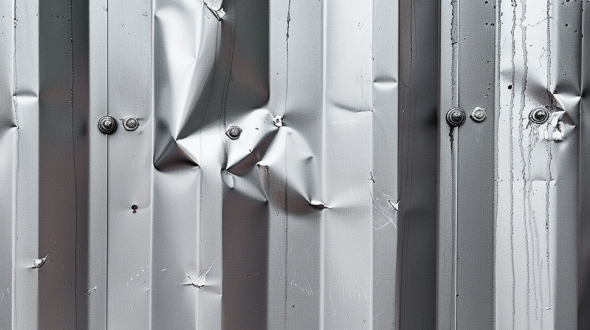
Metal Roof Damage Key Takeaways
- Metal roofs can suffer from leaks, dents, and rust due to environmental factors. However, understanding the common signs of damage like discoloration, unusual noise, and wrinkling panels is vital for early detection and repair.
- Preventative measures such as proper installation, regular maintenance, and protective coatings can significantly extend the life and performance of metal roofs, proving more cost-effective over time compared to post-damage reparations.
- Repair techniques for metal roof damage include smoothing out dents, sealing punctures, and applying rust-preventative coatings. In contrast, severe damage might require a complete replacement, emphasizing the importance of regular roof inspections and maintenance.
Understanding Metal Roof Damage: Common Causes and Signs
Before diving into prevention and repair strategies, it’s vital to comprehend the potential issues that can occur. Metal roofs, though robust, are not immune to the wrath of nature or the passage of time. Various factors can lead to issues such as leaks, dents, and rust.
These issues often manifest in visible signs such as:
- Discoloration
- Unusual noise during windy conditions
- Wrinkling or waviness in metal panels
- Roof seams diverging
Each of these signs points to a different type of damage. For example, discoloration often signals corrosion and rust, while unusual noise can highlight loose or missing metal roof panels. Recognizing these indicators is crucial for swift and efficient damage control.
Hailstorms and Metal Roofs
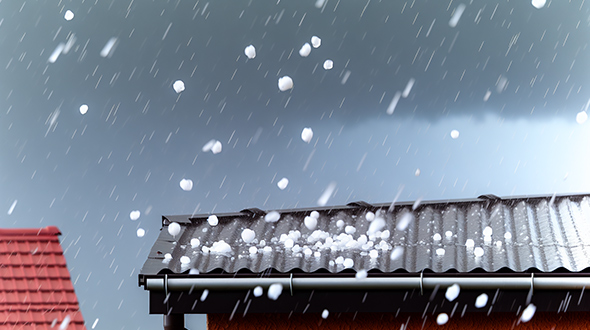
Hailstorms, though brief, can leave a lasting mark on metal roofs. The damage from a hail storm can range from cosmetic dents to functional punctures, with the latter being less common with smaller hailstones. However, even cosmetic damage can lead to more severe problems over time if not addressed promptly.
The slope and underlying structure of a metal roof, along with the thickness and gauge of the metal used, can significantly influence its ability to withstand hail damage. Metal roofs can be assessed for hail impact resistance through the UL 2218 testing standard, which involves dropping steel balls onto the panels to simulate hail. Finishes, such as matte, and features, like embossed metal or stiffening ribs, can help conceal hail-induced dents.
For better hail protection, metal roofing panels with high tensile strength, a suitable gauge like a minimum of 26 gauge steel, and the highest UL Impact resistance rating, such as Class 4, are advisable.
Wind-Related Damage
Wind, though seemingly harmless, can wreak havoc on a metal roof. Expansion and contraction of the metal caused by temperature changes can lead to:
- Loose or missing fasteners increase the roof’s vulnerability to wind uplift
- Dislodged or damaged roofing components
- Flying debris during storms potentially causes punctures or significant structural damage to metal roofs.
Nevertheless, the correct installation and roof deck selection can significantly contribute to wind damage resistance. Some metal roofs can withstand wind gusts up to 140 mph, and certain designs are preferred in hurricane-prone areas. This again emphasizes the need for professional installation and careful selection of roofing materials.
Corrosion and Rust
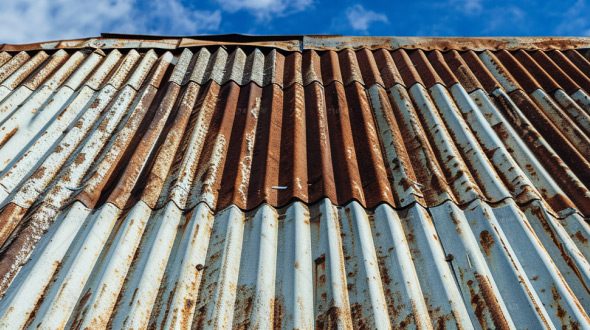
Corrosion and rust are familiar foes of metal roofs. The primary culprit behind these issues is water, as the presence of oxygen in water and moisture can create iron oxide on any iron mass, such as steel. This process is accelerated by the presence of electrolytes such as acidic rain or salty water, especially prevalent near oceans.
Materials such as aluminum and Galvalume, a combination of aluminum and zinc, are more resistant to the corrosive effects of seawater and rust, making them suitable for environments like coastal areas. Additionally, stucco-embossed metal roofs can help reduce the visibility of corrosion and rust, aiding longevity and aesthetic appearance.
Preventative Measures for Metal Roof Damage
As with any preventive measure, averting damage to a metal roof proves more cost-effective over time than dealing with issues post-occurrence. A properly installed metal roof can last for decades, demonstrating significant long-term cost-effectiveness. Key preventative measures include proper installation, regular maintenance and inspections, and the use of protective coatings and treatments.
These measures all contribute to the longevity of a metal roof:
- Proper installation ensures secure fasteners and leak prevention
- Regular maintenance and inspections facilitate the early detection and repair of issues
- Protective coatings and treatments bolster the roof’s defense against environmental elements
The significance of these preventive measures cannot be emphasized enough.
Proper Installation
Correct installation lays the foundation for a durable metal roof. A properly installed and securely tightened fastener is crucial for reducing the risk of wind uplift and preventing panels from becoming loose or detaching. A meticulous inspection of components such as washers and screws is part of proper installation, ensuring that no fasteners are exposed to avoid leaks or other damage.
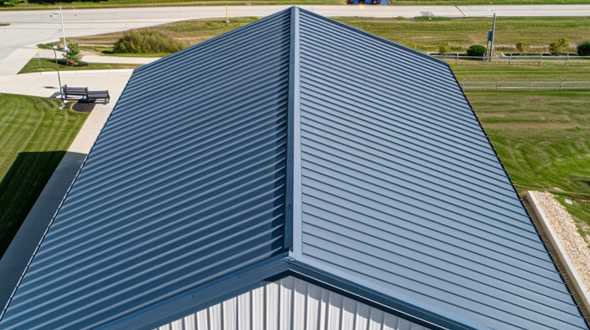
Moreover, a properly installed metal roof can offer the following benefits:
- Last as long as the house itself, with potential lifespans of 40 to 70 years
- Less likely to incur damage from falling limbs and projectiles
- Do not spark or ignite during lightning strikes
Thus, working with a local expert specializing in metal roofing is recommended to ensure the installation is done correctly, maximizing the roof’s lifespan.
Regular Maintenance and Inspections
Consistent maintenance and inspections form the crux of maintaining a sturdy metal roof. Performing regular maintenance and inspections every six months can help detect early signs of problems such as:
- Wind damage
- Leaking
- Denting
- Scuffing
- Scratching
- Corrosion
Proper maintenance ensures the longevity of a standing seam metal roof and extends the lifespan of an asphalt shingle roof.
Structural maintenance should include checking and fixing fasteners, rivets, screws, and seams at least once every two years, while gutters and drains should be cleaned annually to prevent water-related issues; maintenance frequency may increase in extreme climates.
Keeping the roof clear of branches, leaves, and other debris is essential to avoid scuffs or scratches, and regular cleaning of the roof surface helps to extend the roof’s life and maintain its appearance.
Regularly inspecting for punctures from fallen debris and acting promptly at the initial signs of rust is essential to stop further roof degradation. For safety, employing an aerial work platform, using a harness and safety line, or considering a drone for hard-to-reach areas is recommended to avoid accidents.
Protective Coatings and Treatments
Protective coatings and treatments are pivotal in averting damage to metal roofs. These are essential for shielding metal roofs from:
- Sun
- Wind
- Rain
- Corrosion
- Rust
High-quality metal roof coatings, such as epoxy and rubber-fortified acrylics, are designed to encapsulate the commercial roof and withstand significant expansion and contraction, making them excellent prepared roof covering materials.
Spray polyurethane foam (SPF) can be installed over metal roofs to increase R-value and provide moisture damage control through closed-cell insulation. Silicone roof coating systems offer a renewed warranty and are a cost-effective repair option for intact or minimally damaged seams. Besides leak prevention, coatings can enhance thermal performance and insulation, which benefits metal roofs in extreme temperatures.
Protective coatings can be customized in color and formulation to meet specific aesthetic preferences and design requirements for metal roofing systems. Periodic maintenance of metal roof coatings can significantly prolong the roof’s lifespan, sometimes extending it to 20 years or more.
Repairing Metal Roof Damage: Solutions and Techniques
Sometimes, despite our best efforts, issues can arise. When they do, knowing how to repair metal roof damage efficiently and effectively is key. This may involve addressing dents and punctures, fixing leaks and seam separation, and treating rust and corrosion. Severe damage may require extensive measures, such as a complete roof system replacement, which can range from $5 to $9 per square foot.
While these costs might seem high, they are often a necessary investment to ensure the longevity of the roof and the safety of the building’s occupants. Complete seam blowouts and excessive saturation over 25% of the roof area are examples of severe damage that may necessitate a full replacement.
Addressing Dents and Punctures
Dents and punctures can be a common sight after a severe storm. Assessing the size and depth of these damages is crucial to determine whether a patch is necessary or if a full panel replacement is needed. Minor dents can often be smoothed out with tools such as a rubber mallet, while more significant depressions may require a body filler to restore the metal’s surface to its original form.
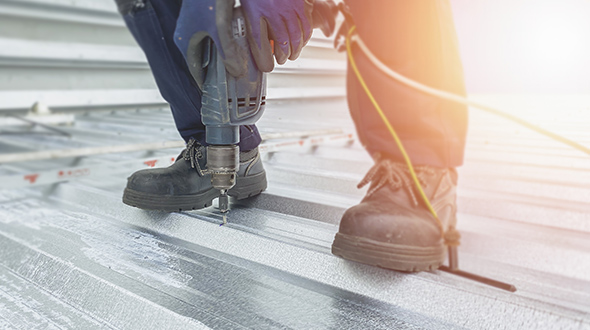
For punctures, a metal patch carefully sealed with urethane sealant is typically the best course of action. This helps to maintain the integrity of the roof and prevent future leakage. Remember, it’s crucial to address even minor damages promptly to prevent them from escalating into more severe issues.
Fixing Leaks and Seam Separation
Leaks and seam separations can cause significant damage if left unaddressed. A thorough inspection by a professional roofing contractor is essential for detecting these issues in metal roofing systems. Roof leaks in metal roofs can often be repaired by replacing worn-out or damaged screws and fasteners, which are typically the weak points where water can infiltrate.
In addition to replacing damaged components, installing a roof coating system is an effective method for preventing leaks and contributing to roof restoration. This involves power washing the roof and applying an extra coating over seams and fasteners after preparation. This not only fixes the current leaks but also helps prevent future ones, making it a worthwhile investment in the long run.
Treating Rust and Corrosion
Rust and corrosion, if left unchecked, can seriously compromise the integrity of a metal roof. When rust appears, it signifies the failure of the protective coating and necessitates immediate remedial action. The most common areas for rust to develop are around the fixings or roof screws and at roof sheet overlaps, particularly if the screw heads are damaged during installation.
Small amounts of rust can be treated by:
- Scrubbing with a wire brush
- Cleaning with hot, soapy water
- Thoroughly drying the area
- Preparing it for a protective coating
Once the rust has been cleaned off, silicone-based paint should be applied to the metal substrate and screw heads to provide a barrier against future corrosion. This ensures that the roof remains strong and durable, capable of withstanding harsh weather conditions.
Choosing the Right Metal Roofing Material for Your Needs
Choosing the suitable metal roofing material for your needs can significantly impact the longevity and durability of your roof. Different materials come with distinct benefits and drawbacks; what works best for one building might not be suitable for another. Factors such as the type of metal, installation quality, and the local climate where the house is located can all play a role in determining the lifespan of a metal roof.
By assessing your local climate and weather conditions and comparing the properties of different materials, you can ensure that you choose the best metal roofing material for your needs. Whether you live in a hail-prone area or a hot and sunny region, there’s a metal roofing material that’s just right for you.
Assessing Your Climate and Weather Conditions
Consideration of local climate and weather conditions is key when selecting a metal roofing material. For instance, in hail-prone areas, choosing metal roofing with a high UL Impact Rating is crucial, indicating robustness against hail damage. Design features like corrugation can better withstand repeated impacts.
In hot climates, metal roofs are advantageous thanks to their ability to reflect UV rays and heat, which contributes to lowering cooling costs and preventing excessive heat absorption into buildings. It’s also worth considering the use of thermal coatings on metal roofs in extreme temperature environments to improve their insulative properties significantly.
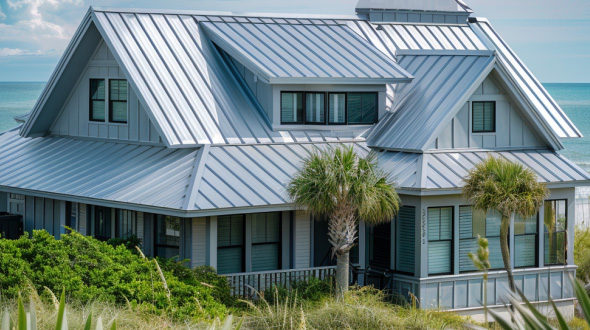
For buildings in coastal regions, aluminum roofing is often the preferred choice due to its enhanced resistance to seawater corrosion compared to other metal roofing materials like steel.
Comparing Metal Roofing Materials
When comparing metal roofing materials, several factors come into play. Metal roofing materials, such as steel, typically come in varying gauges—24 to 26 gauge—suitable for residential applications, with a lower gauge indicating thicker and potentially more durable material. Higher-grade metal sheets offer improved resistance to rust and corrosion, contributing to the overall longevity and durability of the roofing material.
Materials like steel and aluminum each have their own advantages. Here are some key points to consider:
- Steel is known for its inherent strength and lower cost.
- Aluminum is advantageous for certain architectural needs due to its lighter weight and high strength-to-weight ratio.
- The industry standard UL 2218 assesses the impact resistance of metal roofing materials, aiding in determining their durability against hail and debris.
Consider these factors carefully to make an informed decision that suits your specific requirements.
Insurance Considerations for Metal Roofs
Insurance is a crucial factor to consider in the context of metal roofs. Understanding the coverage provided by your insurance company, including hail damage coverage, potential discounts for impact-resistant roofs, and the difference between actual cash value and replacement cost coverage, can save you a lot of trouble down the line. In fact, a metal roofing system with a Class 4 rating for impact resistance may even lead to reductions in homeowners insurance premiums.
However, being aware of the specific terms related to hail damage coverage for metal roofs is important. Some insurance policies for metal roofs include a wind and hail deductible, often 2% of the home’s value, and may even include a cosmetic damage exclusion for incidents like hail or wind. To avoid any future misunderstandings, engage in detailed discussions with your insurance provider before agreeing to any terms.
Hail Damage and Insurance Claims
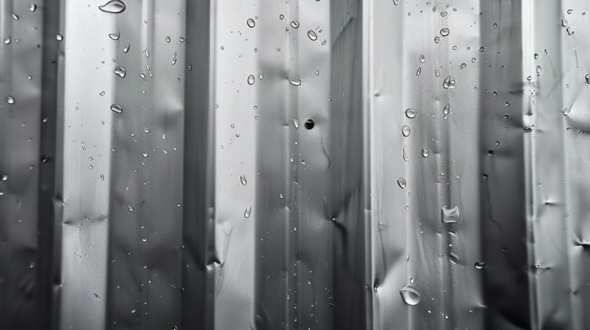
Hail damage insurance claims for metal roofs can vary based on the extent and type of damage. Insurance policies may cover damage caused by hail, so it’s crucial to understand the specific terms related to hail damage coverage. The claims can vary based on whether the damage is considered cosmetic, such as dents or structural. In cases where dents lead to cracking paint or substrate perforation, they may be deemed a failure and thus covered by the policy.
However, cosmetic damage exclusions can reduce insurance premiums but exclude coverage for aesthetic damage from hail that does not impair the structural integrity of the metal roof. This can lead to reduced premiums and a lack of coverage for such damage. To avoid misunderstandings about coverage limitations, homeowners must engage in detailed discussions with their insurance providers before agreeing to hail damage waivers.
Potential Discounts for Impact-Resistant Roofs
Opting for an impact-resistant metal roof offers the potential benefit of insurance premium discounts. Metal roofing systems with a Class 4 rating for impact resistance, recognized under the UL 2218 standard, may lead to reductions in homeowners insurance premiums. Homeowners in hail-prone regions could potentially save up to 30% on their insurance premiums by installing a Class 4 impact-resistant metal roof.
Although not mandatory in every state, an increasing number of insurance providers are offering discounts for homes equipped with impact-resistant roofs. To acquire an insurance premium discount, homeowners must verify that their metal roof meets specific UL or FM impact resistance standards and may need to fill out a discount eligibility form. This is another reason why choosing the right metal roofing material can make a significant difference in the long run.
Metal Roof Summary
Whether you’re a homeowner or a business owner, understanding the nuances of metal roof care is crucial to prolonging its lifespan and maintaining its appeal. From understanding the common causes and signs of damage, such as hailstorms, wind, and corrosion, to preventative measures like proper installation, regular maintenance, and protective coatings, each aspect plays a significant role in maintaining the health and longevity of your metal roof.
Choosing the right metal roofing material, understanding your climate and weather conditions, and keeping insurance considerations in mind are equally important. Remember, a well-maintained metal roof isn’t just a cover over your head—it’s a testament to the strength and resilience of your building, capable of withstanding the test of time and the elements. So why not give it the care it deserves?
Metal Roofing Damage FAQ’s
Read ‘An In-Depth Look at Metal Roofing‘ for more insight. But read below for the most common metal roof damage questions we hear:
Do metal roofs damage quickly?
Metal roofs are highly durable, but their unique characteristics can cause significant damage over time if left unaddressed. Regular maintenance is vital in preventing this.
What is considered functional damage to a metal roof?
Functional damage to a metal roof is any damage that affects its ability to shed water or form a barrier to the elements. This includes damage caused by hailstorms.
Does insurance cover metal roofs?
Yes, insurance typically covers metal roofs and may even offer a discount for their installation.
What is the role of protective coatings and treatments in preventing metal roof damage?
Protective coatings and treatments are crucial in preventing metal roof damage by shielding the roof from environmental elements, preventing corrosion and rust, and enhancing thermal performance.
How can I repair dents and punctures in my metal roof?
To repair dents in your metal roof, use a rubber mallet for small dents and a body filler for larger ones. For punctures, use a metal patch sealed with urethane sealant for a lasting fix.
(404) 220-9288
The post Metal Roof Damage appeared first on atlantacommercialroofingcontractors.com
